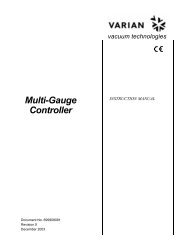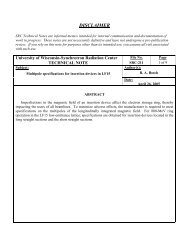SRC Users' Meeting - Synchrotron Radiation Center - University of ...
SRC Users' Meeting - Synchrotron Radiation Center - University of ...
SRC Users' Meeting - Synchrotron Radiation Center - University of ...
You also want an ePaper? Increase the reach of your titles
YUMPU automatically turns print PDFs into web optimized ePapers that Google loves.
FIELD IONIZATION OF CH 3 I IN SUPERCRITICAL AR<br />
C. M. Evans 1 and G. L. Findley 2<br />
1 Department <strong>of</strong> Chemistry and Biochemistry, Queens College – CUNY,<br />
65-30 Kissena Blvd, Flushing, NY 11367<br />
2 Department <strong>of</strong> Chemistry, <strong>University</strong> <strong>of</strong> Louisiana at Monroe,<br />
Monroe, LA 71209<br />
Supercritical fluids have recently been shown to improve rates and modify product ratios<br />
<strong>of</strong> chemical reactions, to vary chemical shifts in NMR, and to alter lifetimes and energies <strong>of</strong><br />
molecular vibrational states. However, the detailed nature <strong>of</strong> the molecule (i.e., dopant)/fluid<br />
(i.e., perturber) interactions that lead to these effects is not well understood. In recent studies <strong>of</strong><br />
the density dependence <strong>of</strong> solvatochromic shifts <strong>of</strong> vibrational and UV-visible absorption bands,<br />
an increase in the energy shift near the critical density along the critical isotherm <strong>of</strong> the perturber<br />
was observed (cf. Fig. 1). In measurements <strong>of</strong> the field ionization <strong>of</strong> high-n CH 3 I Rydberg states<br />
in supercritical argon, we observed a decrease in the shift near the critical density along the<br />
critical isotherm (cf. Fig. 2). Such a dramatic difference in behavior is striking. The densitydependent<br />
shift <strong>of</strong> the dopant ionization energy in dense media can be written as a sum <strong>of</strong><br />
contributions, = w 0 (P) + V 0 (P), where w 0 is the shift due to the average polarization <strong>of</strong> the<br />
perturber by the ionic core, V 0 is the quasi-free electron energy in the perturbing medium and P<br />
is the perturber number density. Our preliminary analysis suggests that while w 0 shifts in a<br />
manner similar to the vibrational and UV-visible band shifts, V 0 does not. Thus, the difference in<br />
behavior between the shift <strong>of</strong> high-n Rydberg states and <strong>of</strong> vibrational (or UV-visible) absorption<br />
bands is due to the interaction <strong>of</strong> the quasi-free electron with the perturbing medium.<br />
This work was conducted at <strong>SRC</strong> (NSF DMR-0084402) and was supported by a grant from<br />
the Louisiana Board <strong>of</strong> Regents Support Fund (LEQSF (1997-00)-RD-A-14).<br />
1996<br />
0.0<br />
1994<br />
-0.2<br />
line position (cm )<br />
-1<br />
1992<br />
1990<br />
1988<br />
(eV)<br />
-0.4<br />
-0.6<br />
1986<br />
-0.8<br />
1984<br />
0 2 4 6 8 10 12 14 16 18<br />
density (mol/L)<br />
Fig. 1. Infrared absorption line peak position <strong>of</strong> the T 1u<br />
asymmetric CO stretching mode <strong>of</strong> W(CO) 6 in CO 2 vs<br />
CO 2 density at (!) the critical temperature <strong>of</strong> 33C and<br />
() 50C. The lines provide a visual aid. (Modified<br />
from R.S. Urdahl, D. J. Myers, K. D. Rector, P. H.<br />
Davis, B. J. Cherayil and M. D. Fayer, J. Chem. Phys<br />
107, 3747 (1997).)<br />
-1.0<br />
0<br />
5<br />
10<br />
15<br />
Ar<br />
(10 21 cm -3 )<br />
Fig. 2. Ionization potential <strong>of</strong> CH 3 I in argon<br />
plotted as a function <strong>of</strong> argon number density Ar.<br />
() -114C; () -118C; () various lower<br />
temperatures other than the critical temperature;<br />
() the critical temperature <strong>of</strong> -122C. The lines<br />
provide a visual aid. (C. M. Evans and G. L.<br />
Findley, to be published.)<br />
20<br />
25
















